
Oncocyclus iris
Iris that comprise the section Oncocyclus are often referred to in floricultural literature simply as "Onco". With respect to relationship they are more close to the section Regelia Their seeds are very similar, the caruncles are of light colour, flower stems are arrow-shaped but bear only one bloom. The rhizomes of oncocycles consist of nutlet-like segments and usually have no stolons. The leaves are glaucescent and sickle-shaped.
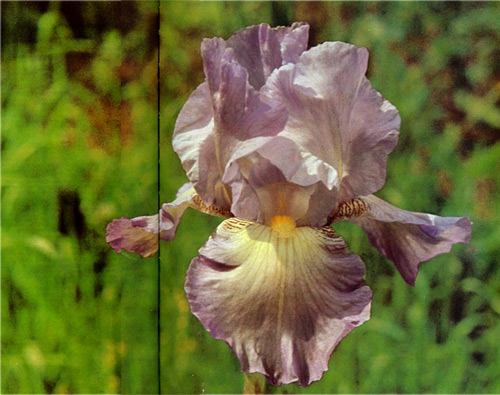
38. 'Akademik Korolev'
Oncocyclus iris occur only in mountain regions of Central Asia, the Caucasus, Iran and the Near East, where the climate is dry and seasonal changes are clearly expressed. In the Soviet Union they are found on the ridges of Kopet-Dag mountains in Turkmenia and in the Eastern Caucasus, from the environs of Tbilisi in the west to the Kaspian sea shore in the east.
In summer, with the onset of dry and hot weather, vegetative organs of oncocycles die back and only the rhizomes survive, although they may seem lifeless at first sight. In autumn, when the weather becomes wet and cool, the rhizomes shoot bunches of leaves and in this state plants overwinter. Approximately by mid-February the weather becomes warm and the foliage starts growing. From April till early May plants develop flower buds and begin to bloom. Under the temperatures of 23 to 25 °C blooms live for 4—5 days. The flowering period does not exceed 15 to 20 days.

39. 'Gvardejskij'
Such a growing habit has been developed in the long course of evolutionary process and is so strong that persists in oncocycles grown under any conditions.
These peculiarities are necessary to be regarded if one wishes to cultivate oncocyclus iris.
The experience of B. D. Gavrilenko (a botanist from Tbilisi) has shown, that oncocycles possess a valuable property, i.e. their bloom opening can be retarded by 4-5 days if flower stalks with ready to bloom buds are tightly packed in paper. This time is sufficient to dispatch boxes with flowers to different distances.
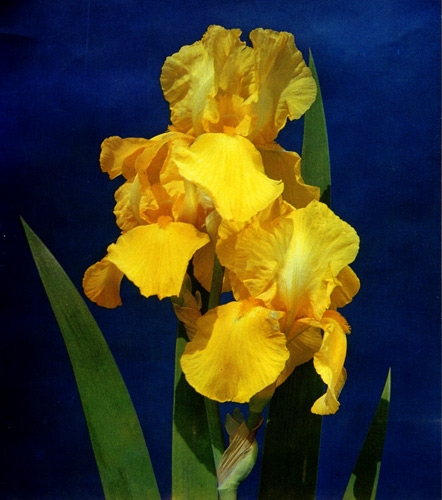
40. 'Moskva Zlatoglavaja'
The virtue of the group is the possibility of forcing. Seasoning of ready to shoot rhizomes under low positive temperatures in early September and their subsequent transfer to a well lighted greenhouse forces the plants to bloom in 65 to 75 days.
All oncocyclus iris pertain to the species to be conserved. Collection of the rhizomes is forbidden and only the seeds may be used for propagation.
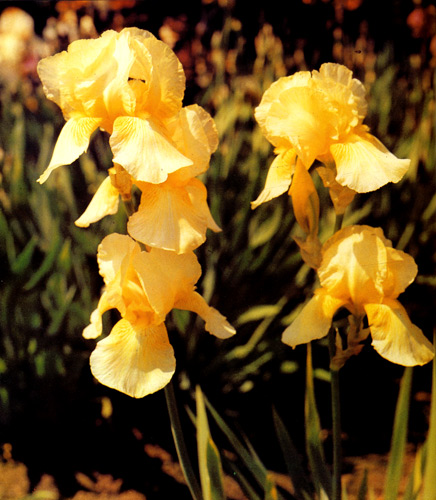
41 'Pervenetz'
Oncocycles native to the Soviet Union are divided into three groups by their perianth segment width.
Broad-Segmented or Broad-Petalled Species Group
Iris iberica — one of the most beautiful oncocycles. Its wild forms occur only in Eastern Georgia and West Azerbaijan. The flower is treated in Georgia as a symbol of beauty of the Georgian nature.

42. 'Elegia'
The size of the bloom is about 10-13 cm (vertical length). The hight of flower stems with the bloom is, as a rule, 20—25 cm but sometimes reaches 50 and even 60 cm. The inner perianth segments are milky-white, tender-creamy or pale-violet with a faintly visible net of more thin and dark veins. The falls seem dark-chocolate thanks to dense velvet-like veins and marks on a creamy background and bear a large black velvet-like spot in the center. Being easily crossed in nature with other species it produces a lot of valuable hybrids.

43. 'Zolotoje Runo'
Iris elegantissima is a species closely related with Iris iberica. It is distinguished by larger blooms on short flower stems and broad rounded falls, occurs in South Armenia and neighbouring regions of Turkey. Their flower size and a great variety of natural forms is amazing.
Iris lycotis possesses very large blooms, sometimes up to 20 cm in diameter, of purple-brown shades. Standards are often lighter in colour and larger in size than the falls. The height of flower stems may reach 50cm in separate plants. The iris greatly varies in size, shape and colour of flowers. It is native to Nakhichevan and probably North Iran.
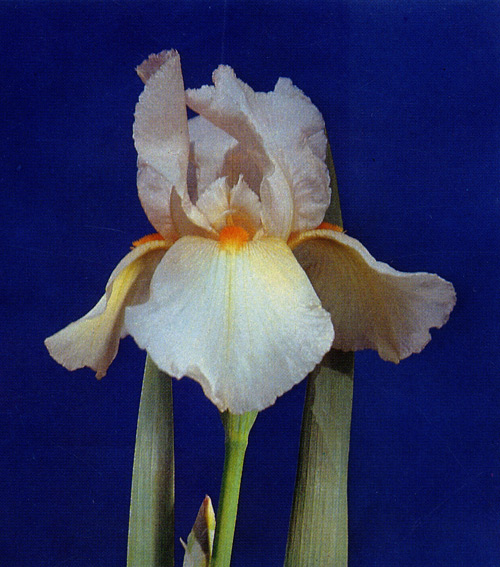
44. 'Oda Vesne'
Iris camillae is unique in beauty. It is represented in the nature by a great number of hybrid forms. The flowers are tinted in very tender and light colours which turn from one shade to another. The "beard" hairs at the base of the falls are usually lemon-yellow. Some forms have a tender fragrance, the feature rarely met in the group. It is native to a small region of West Azerbaijan.
Narrow-Segmented or Narrow-Petalled Species Group
Iris acutiloba is a low plant, up to 12-15 cm high, although sometimes taller specimens occur. Perianth segments have acute tips, the outer ones bear two dark spots. The net of veins on a pale-grey background is delicate and often without marks or stripes. The species greatly varies in the colour of flowers. It is native to the eastern regions of Azerbaijan and reaches in the north the environs of the city of Makhachkala.
Iris ewbankiana is possibly one of the parents of the Iris oncocyclus group. The flower resembles I. acutiloba in shape and colour. It occurs in the mountains of Kopet-Dag in Central Asia, in the northern regions of Turkey and Iran and in Central Azerbaijan.
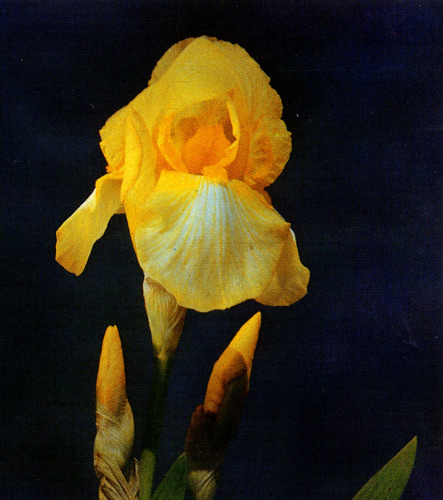
45. 'Polesskij Sheik'
Iris grossheimii is distinguished from I. acutiloba by oblong blunt or rounded standards and falls, the standards are of dark colours and the falls bear a spot.
Similarly to other species it varies in the shape and colour of flowers. It is native to the south-eastern part of the Caucasus and probably to the adjoining regions of Iran.
Iris schelkownikowii is an exclusively decorative species. The flowers are of tender light shades. Among the plants usually being 12cm high separate ones may be as tall as 20 to 30 cm. A characteristic feature of the species is a faint violet-like fragrance which becomes particularly strong in day time, in the sunlight. It occurs in Central Azerbaijan and the Kura left-bank area.
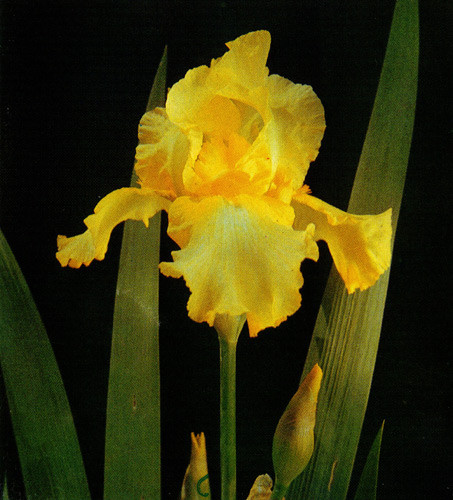
46. 'Solnechnyi'
Group of Species with Broad Standards Oblong Falls
Iris paradoxa is interesting for dark violet-purple flowers with narrow densely haired (like a bumble-bee back) falls and large rounded standards. The forms are also known with blue standards an yellow falls. In the places of inhabitance they produce crosses with other species. It is native to Central Azerbaijan, the Kura right-bank area, Armenia and North Iran.
Iris medwedewii is very close to I. paradoxa species and differs from it by a spathulate shape and pale-creamy colour of inner perianth segments. It occurs in the south-eastern regions of the Caucasus and North Iran.
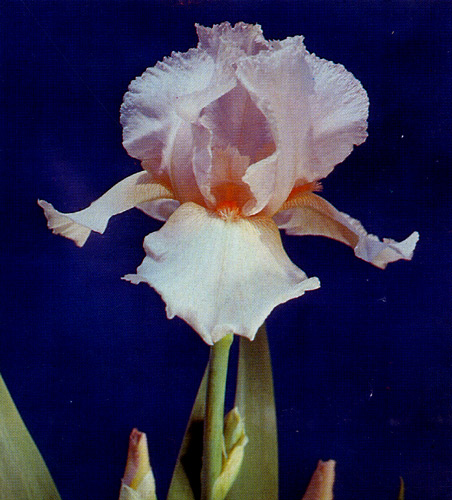
47. 'Vosmoje Marta'
Consequently, a great number of species characterized by considerably limited areals of distribution, grows in the Caucasus. A lot of natural hybrids at the area! boundaries often possess an exquisite fragrance and such decorative merits that represent rich varieties created by the nature.
Although the idea of Oncocyclus iris cultivation is very attractive, yet it is rather difficult to be brought into life. The plants may be grown only in the regions very similar to those of their natural habitat in soil and climate conditions. Cultivation of the wild rhizomes does not bring a reliable success even if they are grown in the regions with dry and hot summer.
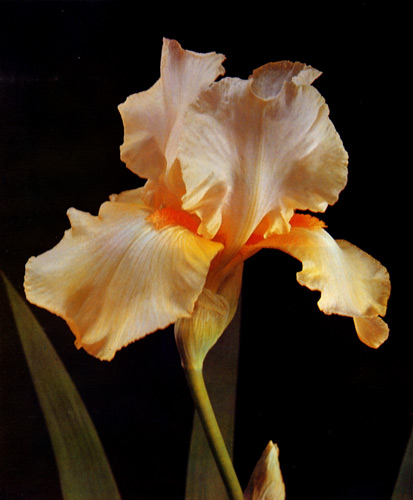
48. 'Starinny Romans'
Scientists seek for reliable methods of these natural gems cultivation as well as suitable regions for their growing.
In the USA such suitable places have been found in the states of Arizona, Texas and particularly California, where the Aril Society, an amateur organization, was set up in 1955.
The work is in progress on developing techniques which would make it possible to raise oncocycles in the regions with wet and cool summer and at least satisfactorily if not successfully.
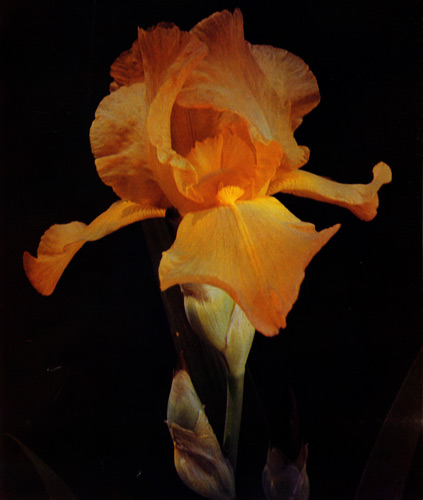
49. 'Mednyi Vsadnik'
Michael Hoh, a Dutch scientist, has worked out a method of after-ripening the oncocyclus rhizomes. He digs them out of the soil when vegetation is completed and places in thermostates. The rhizomes are stored there for 2—3 weeks at +35° to 45 °C. After that the temperature is decreased to +23°-25°C and the relative air humidity maintained at 50-60%. Then, the rhizomes are placed in dry sand and stored till late autumn. In November the rhizomes are planted in sandy soil and covered with a mulch of straw. This period is sufficient for the rhizomes to root and in spring the iris start blooming. Mineral fertilizers are recommended for dressing.
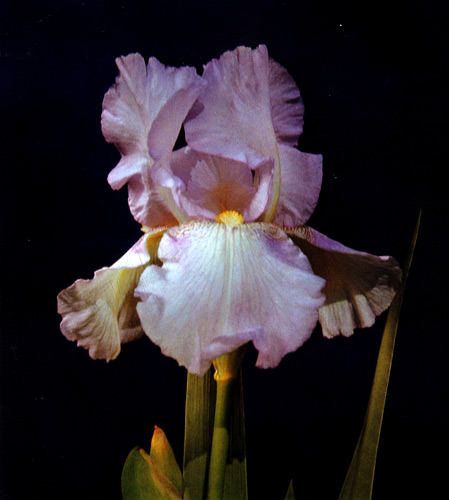
50. 'Rodnik'
If one will try this method in the USSR, in particular in the north-western regions, it is necessary to bear in mind that if the rhizomes are planted late in autumn they may have insufficient time to root.
Hybridization proved to be a more reliable method which has given good results with many cultivated flowers. In our case it should be aimed at creation of oncocyclus iris possessing wider ecological properties. Pogocycles, the hybrids of bearded iris with oncocycles, were developed in England in 1883. The fact, that I. gatesii which was repeatedly brought to Leningrad for growing in the open or in greenhouse invariably died down, whereas its hybrids 'William Mohr' and 'Lady Mohr' grew well for over ten years, shows that hybridization may lead to broadening the boundaries of the Oncocyclus iris cultivation area.

51. 'Yunost'
We have many regions in the Soviet Union where oncocyclus cultivation may be successful, even if its wild species are used. Promising results have been obtained at the Botanical Institute in Tbilisi and Botanical Gardens of Baku, Erevan, Kiev, Yalta and Tashkent. Very interesting work on hybridization was first carried out in Tbilisi by botanists N.A. Kakheladze and B.D. Gavrilenko and later in Tashkent by M.I. Rozhanovskaya.
Oncocycles are propagated by the rhizome division during the dormant summer period. The seeds are sown in August—September and their germination lasts for several years. A method of the germ cultivation on agar-agar proposed by Randolph (1945) is practiced to hasten the germination process.
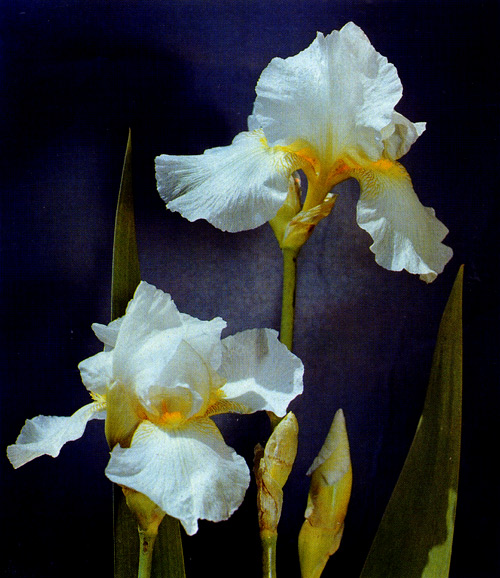
52. 'Nezhnost'
Many years' experience of B.D. Gavrilenko with oncocycles in Tbilisi enables us to give the following recommendations concerning their cultural requirements:
1. The iris may be cultivated in the regions with annual precipitation of about 500 to 600mm (predominantly in autumn, winter and spring time) and at winter temperatures not lower than - 15 °C.
2. The sites for growing the iris should be chpsen on the southern well lighted slopes (the flowers will not withstand any shade) with well drained soil and good run-off of rain waters.
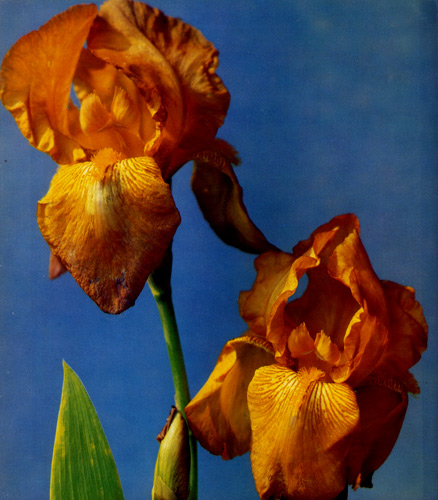
53. 'Ryzhik'
3. The soil must be sandy, calcareous, without admixture of organic fertilizers and of loose texture.
4. Only mineral fertilizers are recommended.
5. Watering should be applied exclusively during vegetation periods, moderately in autumn and more heavily in spring.

54. 'Abkhazia'
6. On completion of the vegetation the rhizomes should be digged out of the soil and stored at +25° to 35 °C till replanting in autumn. The rhizomes must be cleaned out of dead parts and divided so that the central larger upper sections could be selected for further flowering.
7. It is advisable to plant the rhizomes before late September.
In recent times oncocyclus iris occurred in nature in abundance. At present, however, they find protection only in places not suitable for ploughing or livestock grazing, i. e. ravines, gullies, or karst gaps, on edges of precipices and on the so called abandoned lands.
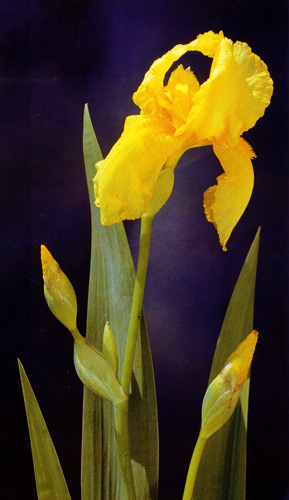
55. 'Оlimpijskij'
|
ПОИСК:
|
© FLOWERLIB.RU 2001–2022
При использовании материалов активная ссылка обязательна:
http://flowerlib.ru/ 'Библиотека по цветоводству'
При использовании материалов активная ссылка обязательна:
http://flowerlib.ru/ 'Библиотека по цветоводству'